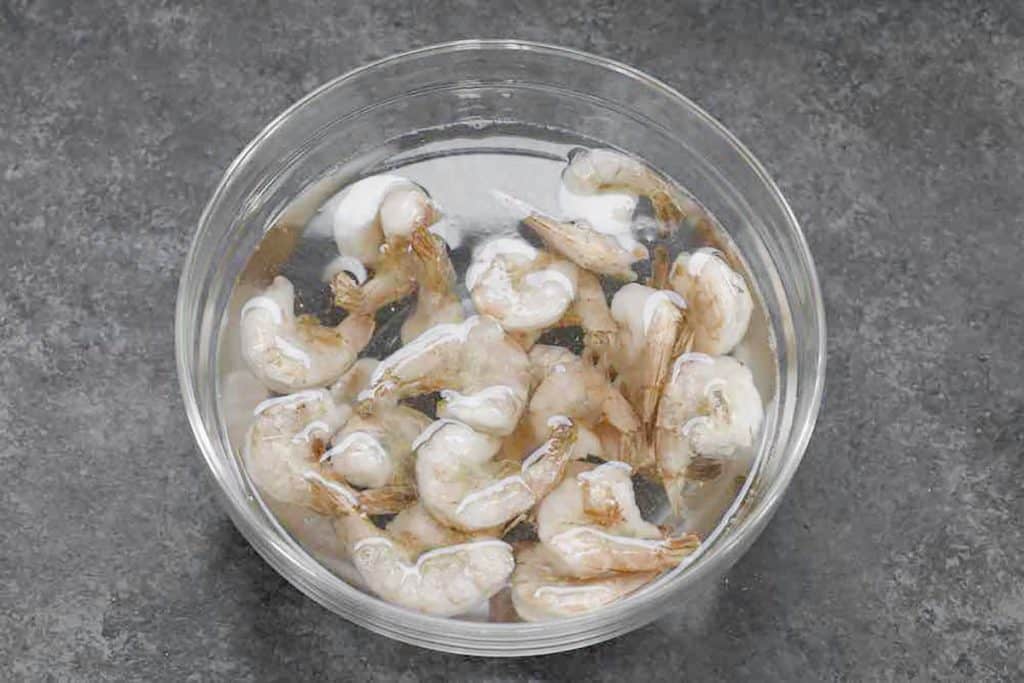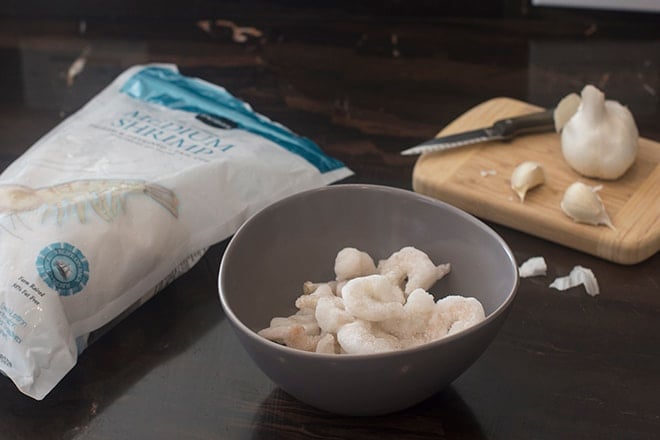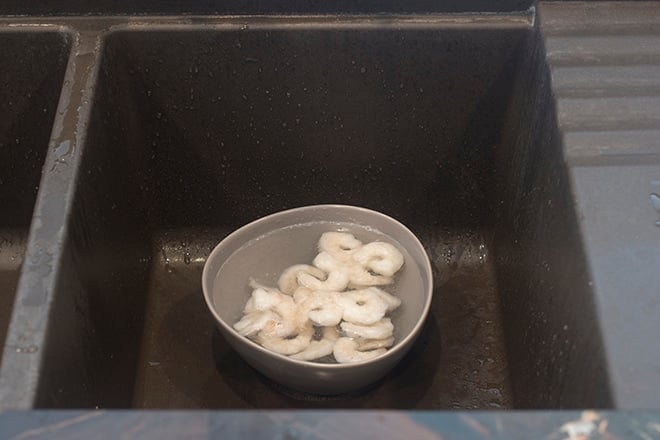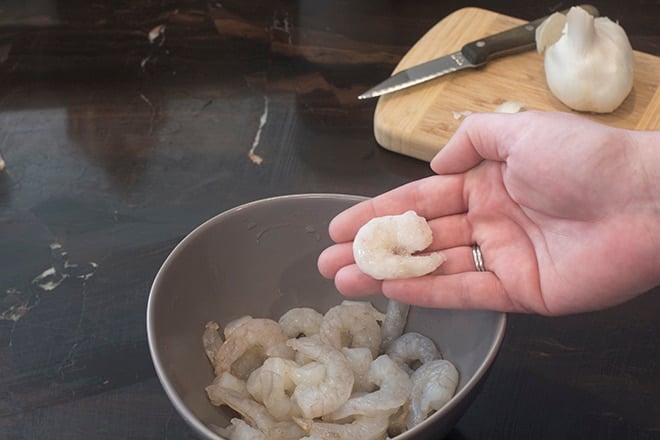Shrimp are often frozen right on the boat after being caught. This is the best way to get them to you fresh and tasty. You only need to let them thaw for a few minutes before you can start cooking them in your favorite shrimp recipes.
But keep in mind that you can cook shrimp from frozen and they will still taste great if you’re in a hurry. Weeknight dinners are saved! If you still want to thaw them before cooking though, the info is below.
Thawing frozen shrimp in water is a quick and convenient method that many home cooks rely on However, there are some important guidelines to follow when thawing shrimp in water to ensure food safety This article will cover the proper techniques for thawing shrimp in water, explain why it works, look at some alternatives, and offer tips to prevent problems.
Why Thaw Shrimp in Water?
There are a few advantages to using water to thaw frozen shrimp
-
Speed – Thawing in a bowl of cold water can defrost shrimp in 10-20 minutes, much faster than leaving them in the fridge overnight. This makes it a good option when you forgot to thaw the shrimp or need them thawed ASAP.
-
Temperature Control – The cold water prevents the outer surface of the shrimp from warming too much during the thawing process Warm temperatures promote bacterial growth
-
Even Thawing – The water is able to circulate around the entire surface of the shrimp, allowing them to thaw evenly. Uneven thawing can lead to overcooked spots when cooking.
-
Simple Method – All you need is a bowl of cold tap water. No special equipment required.
So thawing in water offers a quick and easy way to defrost shrimp when you’re short on time. But there are some guidelines to follow for safety.
Proper Technique for Thawing Shrimp in Water
Here is the proper technique for safely thawing frozen shrimp in water:
-
Use cold tap water – You want the water to be cold but not ice cold. Avoid using hot water as it will start to cook the shrimp.
-
Allow full submersion – The shrimp need to be completely covered by the water to thaw evenly. Weigh them down with a plate if needed.
-
Change water as needed – Replace the water if it starts to warm up. This keeps the shrimp chilled.
-
Thaw for 10-20 minutes – The thawing time can vary based on size. Check shrimp periodically to avoid over-thawing.
-
Pat dry – Drain the thawed shrimp on paper towels before cooking to prevent excess water absorption.
Following these steps will result in thawed shrimp ready for cooking without any unsafe temperature changes during the process.
Why Does Thawing in Water Work?
Thawing shrimp in cold water is an effective technique because of the principles of heat transfer at work. Heat flows from areas of higher temperature to areas of lower temperature. Here’s what’s happening:
-
The frozen shrimp are at a very low temperature. The cold water, while higher than the frozen state, is still cold.
-
Heat from the outer surface of the shrimp begins transferring into the surrounding cold water, causing the shrimp to gradually thaw from the outside in.
-
The cold temperature of the water prevents excessive warming of the shrimp’s outer surface, keeping them safe.
-
The circulating water allows the heat transfer to occur evenly over the entire surface of the submerged shrimp.
Understanding how the physics allows the shrimp to thaw quickly without warming too much makes it clear why water thawing works so well.
Alternatives to Thawing in Water
While water thawing is quick and convenient, it’s not the only option. Here are a few alternatives:
-
Refrigerator Thawing – Place frozen shrimp in a bowl in the fridge overnight or up to 24 hours to thaw. No water needed.
-
Microwave Thawing – Defrost shrimp in 30 second bursts in the microwave, checking often to avoid cooking.
-
Cold Air Thawing – Place frozen shrimp on a tray at room temperature and allow the cold air to gradually thaw them.
-
Cook Frozen – For dishes like shrimp stew or stir fry, you can sometimes cook frozen shrimp directly without thawing first.
Each method has pros and cons, so consider which works best for your specific needs. The water technique remains one of the quickest and simplest.
Tips to Avoid Problems When Thawing Shrimp in Water
While thawing shrimp in water is generally safe, there are some potential pitfalls to be aware of:
-
Use very cold, but not icy water. Icy water may freeze the outer surface.
-
Don’t thaw for too long, which can cause the shrimp to become mushy.
-
Change the water if it starts warming up to prevent bacterial growth.
-
Pat shrimp dry before cooking so they don’t absorb excess water.
-
Don’t leave thawed shrimp at room temperature for long periods. Refrigerate.
-
Don’t re-freeze thawed shrimp. Cook them within 1-2 days.
With care taken to avoid these issues, thawing shrimp in cold water can be a fool-proof method trusted by professional chefs and home cooks alike.
Frequently Asked Questions About Thawing Shrimp in Water
Here are answers to some common questions about this thawing technique:
How long does it take to thaw shrimp in water?
Shrimp generally take 10-20 minutes to thaw in cold water depending on size. Jumbo shrimp may take slightly longer. Check frequently after the first 10 minutes.
Can you thaw already cooked shrimp in water?
Yes, thawed pre-cooked shrimp stored in the freezer can also be thawed in cold water using the same method. Pat dry afterward.
Is it safe to thaw shrimp at room temperature?
No. Room temperature thawing can cause bacterial growth. Always thaw in the refrigerator or cold water.
Should you use hot or warm water to thaw shrimp faster?
No, hot water will start to cook the shrimp and should be avoided. Use only cold tap water.
Can thawed shrimp be refrozen safely?
It is not recommended to refreeze thawed shrimp. Cook within 1-2 days and do not refreeze.
Thaw Shrimp Safely With Cold Water
Thawing frozen shrimp using a bowl of cold tap water is a quick, easy, and safe technique that even professional chefs rely on when time is limited. Following the proper guidelines carefully prevents bacterial growth and results in thawed shrimp ready for cooking. While there are some alternative thawing methods, cold water remains one of the most convenient options trusted by home cooks. Just be sure to avoid common pitfalls like over-thawing or improper temperatures. Master this simple shrimp thawing trick and you’ll always have these tasty crustaceans ready to go for all your favorite recipes.

How To Cook Your Defrosted Shrimp
Here are my some of favorite methods to cook your thawed shrimp. Enjoy!
Here’s How To Thaw Shrimp Quickly:
Put the shrimp in a bowl that’s twice as big as the shrimp you have. Here I have 24 medium shrimp (51-60 count) and I’ve used a medium bowl.


Put the bowl in the sink and fill with cold water.
Keep the tap running gently until the shrimp are defrosted. This will take about 5 minutes.

The shrimp are fully thawed when they are no longer solid white but soft and somewhat see-through. Here is a shrimp that is still frozen. It is whiter and less clear than the shrimp in the bowl that has been defrosted.

Once the shrimp are defrosted, it’s time to cook them up.
